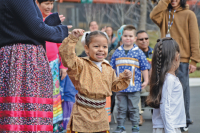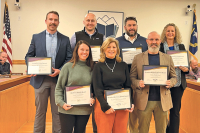Path to the past: Friends of the Smokies hike explores park history and natural beauty
 There was no doubt about how the Smoky Mountains got their name as day dawned on the Friends of the Smokies’ planned hike to Hemphill Bald. Sky seemed to meet earth as the carpool headed up the mountain from Maggie Valley, fog so thick the road 20 feet ahead could have been imaginary. It didn’t look like the bald at the end of the 4.4-mile hike would offer much of a view that day.
There was no doubt about how the Smoky Mountains got their name as day dawned on the Friends of the Smokies’ planned hike to Hemphill Bald. Sky seemed to meet earth as the carpool headed up the mountain from Maggie Valley, fog so thick the road 20 feet ahead could have been imaginary. It didn’t look like the bald at the end of the 4.4-mile hike would offer much of a view that day.
The gloomy weather didn’t drive away Patrick Murphy, however, who’d come over from Bryson City to try out his first Friends of the Smokies hike. The morning was “dismal,” Murphy said, but not without its high points — the first one to arrive at the trailhead, he found himself sharing the spot with two elk.
And it wasn’t too gloomy for me, either, because I just had to believe that the mountains would stay true to their character of ever-changing weather and eventually drive away the clouds.
With every step, that prediction seemed increasingly likely to come true. A half-mile into the gently undulating ridge trail, I’d shed my raincoat and the long pants covering my shorts. An undefined brightness growing from the thinning layers of cloud and fog increasingly illuminated the color-saturated leaves and mosses of the summer forest, cover occasionally breaking just enough to allow a sunbeam to slant through the canopy.
Smokies scenes like this have played out for centuries and even millennia, I reflected as one such sunbeam fell across the trail. But this most recent epoch of the national park’s existence is only a small part of what’s made this place the way it is.
To Danny Bernstein, an author and hiking guide who leads Friends of the Smokies’ monthly hikes, it’s this pre-park history — the people part of history — that’s the most captivating.
Related Items
“It’s fascinating to me that people lived here,” she said. “Personally, that’s more interesting to me than the natural stuff.”
The Smokies are littered with old cemeteries, remains of homesteads, abandoned roads, gnarled old fruit trees that once fed families — it’s these shadows of human communities who once called the park lands home, as well as the park’s natural beauty, that Bernstein seeks to highlight in her hiking routes.
Some of those shadows, though, still retain a solid form. Such is the case for the Alexander family of Cataloochee Ranch, whose border with the park the Hemphill Bald trail follows until reaching its destination, a grassy overlook overlooking wave upon mountain wave. The bald itself is Cataloochee property, and that’s where Judy Coker came riding up on a four-wheeler to meet the group.
“I’m so bloomin’ lucky to have been born into the family I was and more or less inherit as a gift this place,” said Coker, whose father Tom Alexander was the original founder of Cataloochee Ranch. “I feel my whole job for the rest of my life is to take care of it.”
Tom’s connection with the Southern Appalachian mountains goes back to the 1930s, when he spent the summer estimating timber values in what would eventually become the Great Smoky Mountains National Park. When the company he worked for went bankrupt, he let them settle their debt with him by handing over an inventory of camping equipment, with which he set up a fishing camp for tourists in the Three Forks area of the mountains. He followed that enterprise up by running a guest ranch in the newly acquired Cataloochee Valley area of the park until, Coker said, he realized that navigating the red tape and restrictions of work with the federal government was more trouble than it was worth.
Alexander moved to Florida to work in forestry again, but he soon realized that he had “a very severe case of mountain fever,” Coker said. So, he came back north and bought 1,000 acres — most of which remains in the family today — for $10,000, a sum he paid back within two years.
There have been some “bumps in the road” of Cataloochee’s relationship with the park — namely, an episode when the park took Tom to court for shooting a bear that had been repeatedly attacking his cattle (Tom wound up being acquitted) — but by and large, the relationship is a good one and the shared property line is one of the ranch’s most important assets, Coker said.
“We count it really as an opportunity,” Coker said. “Our guests can hike up there and they’ve got another 500,000 acres.”
Coker also counts it as an opportunity to tell her family’s story, because it’s all caught up in the park — her father’s love for the forest, the episode with the bear, the property line that’s a portal to the miles of woodland the park encapsulates, the family’s decision to protect part of their adjoining land with a conservation easement to prevent future development.
And also, with some less savory elements of the past, like the park’s acquisition of Cataloochee Valley, which with a population of about 1,200 people was the largest community in the Smoky Mountains. To this day, Coker takes issue with the federal government’s decision to claim Cataloochee — nearly 100 years later, bitterness remains among those whose families were forced to leave.
“I feel the same bitterness, because I was born when they were in Cataloochee Valley,” Coker said.
That’s why Susan Tedcastle, of the Canton area, comes on Friends of the Smokies hikes — to learn about the mountains in a way she couldn’t just hiking around on her own.
“I just think it’s fascinating to learn how people developed this area and the tragedies they went through,” said Tedcastle, for whom the Hemphill Bald hike marked her sixth with the group.
Life was hard in those early days, as evidenced by the proliferation of cemeteries in the park with markers denoting early deaths. And the transition from mountain community to uninhabited park was rocky. But, as the sun broke out over Hemphill Bald, illuminating the expanse of Cataloochee Ranch, the green runs of Cataloochee Ski Area and the mountains leading toward Maggie Valley, the beauty of the present was clear.
But that’s no reason to forget the past.
“I think the younger generation should remember,” Coker said.
Get out there
Friends of the Smokies takes a hike every month — usually the second Tuesday of the month, usually on the North Carolina side of the Great Smoky Mountains National Park — that offers a chance to see the park while also contributing toward a fund to reconstruct high-use trails in the Smokies.
Non-members pay $35 and receive a one-year membership as part of the deal; members pay $10. The money supports the Trails Forever program, an endowment now worth $5 million that funds a full-time crew to work on the park’s most heavily used trails.
The 2015 hike schedule is online at www.friendsofthesmokies.org/product/hike-the-smokies.
Showing off the Smokies
Danny Bernstein is quite clear about how, exactly, she wound up volunteering her time to lead Friends of the Smokies’ monthly hikes through the Great Smoky Mountains National Park.
“She didn’t say, ‘Danny, would you like to volunteer,’” Bernstein said of Holly Demuth, Friends of the Smokies’ North Carolina director. “I would have said no, because I was too busy. She said, ‘Danny, would you like to lead a hike.’”
That was in 2011, and now Bernstein is in her fifth year of leading monthly hikes to show off the North Carolina side of the park.
“Most people think of the Smokies as Tennessee,” she said, but the North Carolina side has more trail miles than its neighboring state. Bernstein, an experienced hiker with roots in New York City, is “thrilled” about living so close to such a hiker’s paradise of a national park and intent on showing others both the iconic hikes and little-known gems of the Smokies’ 900 miles of trail. She’s pretty enthusiastic about the national forests, too, having hiked the Mountains-to-Sea Trail and written a variety of hiking guides on the North Carolina mountains.
“I’ve grown up in cities. I currently live in a city,” said Bernstein, who lives in Asheville. “I don’t need land. I’ve got it all here. It’s free and I don’t have to mow the lawn.”









